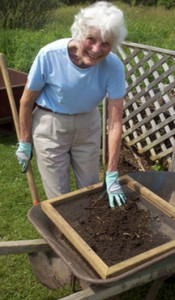designed for the way women work.

“The Curious Gardener” May, 2012
Category: How-To Projects
In This Issue:
My Mother’s Garden
A Brilliant Orchid Show in NY
Grow Stockier, Bushier Tomato Plants This Year
My Mother’s Garden — Recently I spent an afternoon gardening with my mother in northwestern Connecticut, just about 30 miles north of where I live, so that I could observe first hand what her secret to a beautiful garden is.
When I got there she had her shovel deep in her compost bin. Then she dropped the compost on a screen positioned over her wheelbarrow and began rubbing it through the screen. The result was the most perfect soil I have ever seen.
When I got home I immediately built my own screen (not as well engineered as the one my father built for my mother, but serviceable anyway). It’s a laborious process sifting soil through the screen, but is well worth it for the fine texture it provides to young plants and seeds.
My mother is a vigorous lifelong gardener with many varied and naturalistic gardens on her property, and a small pond which provides a focal point behind the house. She also has a vegetable patch which produces broccoli, brussel sprouts, lettuce, tomatoes and beans. She finds that the rule in her garden is ‘one for me and one for the rabbits.’ Sometimes it’s two for the rabbits to her one.
When ambling with her through her gardens she points out the lavender that came from a friend, or the Iris she transplanted from their former home in Weston, CT. There’s one small plant I divided last season and gave to her, a chocolate-y heuchera caramel. In my garden half of the plants are from my mother’s garden, divided over the years and dropped in a pot or wrapped in wet newspaper for transporting to my garden.
It’s part of the fun and the ritual of gardening, the sharing and recalling where our plants came from. My mother’s sister in Minnesota has poppies that came from my great uncle’s garden in Emmetsburg, Iowa. He died at the age of 97, over 30 years ago, but his poppies still live. When we look at the poppies we think of Uncle Harold. I have asked her to collect seeds for me so I can try propagating them in my greenhouse next Spring.
I remember many years ago my grandmother showed me a somewhat tattered photo she had of her perennial garden, established along a high riverbank back in Iowa where my mother and her sister and brother grew up. Although the picture was in black and white I could tell my grandmother saw all the colors in her garden when she looked at it. She loved looking at that picture.
Gardening is about the past, the present and the future—and the connections we make between them. A love of gardening is a wonderful gift to pass on to others. Thank you Mom, and Happy Mother’s Day!
Below are pictures I took last summer of my mother’s garden in northwestern Connecticut. Click on the images to see them larger (and then click the back button to return to the newsletter. If you ‘X’ out of the photo you will lose your connection to the website and newsletter).
A Brilliant Orchid Show in NY–  Patrick Blanc, the French botanist and artist who is known for creating what is called vertical gardens, was invited by the New York Botanical Garden to design their annual orchid show this Spring. The idea of presenting orchids artistically arranged on vertical walls is brilliant. It made the orchids seem more interesting to me, and it also created a sense of order that I appreciated. With hundreds of orchid species on display, it could have felt chaotic but it didn’t. According to Patrick Blanc, it was a new experience for him to work with so much color, since most of his vertical plant walls use non flowering, but highly textured plants. In fact, he brought in many of his favorite plants to complement the orchids.
Patrick Blanc, the French botanist and artist who is known for creating what is called vertical gardens, was invited by the New York Botanical Garden to design their annual orchid show this Spring. The idea of presenting orchids artistically arranged on vertical walls is brilliant. It made the orchids seem more interesting to me, and it also created a sense of order that I appreciated. With hundreds of orchid species on display, it could have felt chaotic but it didn’t. According to Patrick Blanc, it was a new experience for him to work with so much color, since most of his vertical plant walls use non flowering, but highly textured plants. In fact, he brought in many of his favorite plants to complement the orchids.
There was so much picture taking at the show that that was a spectacle itself. People were going in for the close up shots and people were getting pictures taken of themselves with the orchids and so on. Here are some of the pictures I took at the show. I have entered two of them in a photo contest. If you have a favorite please let me know!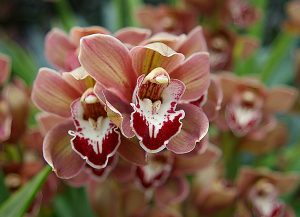





Grow Stocker, Bushier Tomato Plants This Year– My instructor at The New York Botanical Garden gave us a tip on growing the sturdiest tomato plants indoors, before transplanting outdoors. This gives plants a head start on the growing season, and gives them a much better chance of surviving the transition from indoors to outdoors.
Tomatoes, unlike many plants, will grow roots right along their stems once the stem is buried. So, when transplanting to a larger pot indoors, you can practice what is called ‘trenching’. It means turning the root ball of the plant on its side in the new pot, then gently forcing the stem upwards, and staking it if necessary. With each successive planting in a larger pot the soil comes right up to the bottom branches, resulting in a stockier, bushier plant when it comes time to plant outdoors. If you practice this your tomato plants will have a thick stem by the time it’s warm enough to plant out.
Follow these instructions to learn how to trench your tomato plants.
Step One: Start with a tomato plant that needs a larger container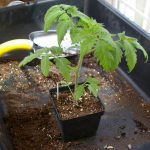
Step Two: Tap the bottom corner of the pot on a hard surface to loosen the plant. If you need to pull the plant out of the container, pull gently by the lower leaves, not by the stem. (Leaves are more dispensable than the stem, if you happen to damage one).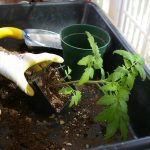
Step Three: Lay the plant in the larger pot sideways.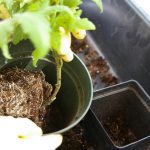
Step Four: Bend the stem up gently.
Step Five: Fill in soil around the root ball and the stem. You can stake the stem if necessary, but I didn’t need to.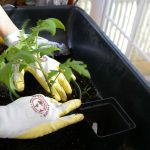
Step Six: Water with a weak solution of fertilizer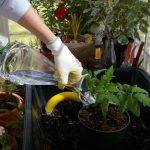
Step Seven: Newly potted tomato plant will grow bushier and stockier than if you had not trenched it.
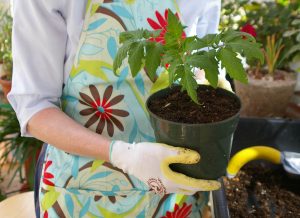 Note: The apron I am wearing was designed by Felicity Miller for Womanswork. Sold at HomeGoods this Spring, along with matching gloves and hats (sold at TJMaxx and Marshalls). Gloves shown are Womanswork Nitrile Weeding Gloves.
Note: The apron I am wearing was designed by Felicity Miller for Womanswork. Sold at HomeGoods this Spring, along with matching gloves and hats (sold at TJMaxx and Marshalls). Gloves shown are Womanswork Nitrile Weeding Gloves.


